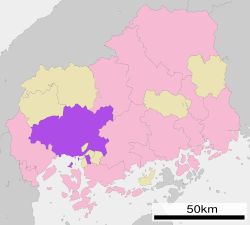
Back Hirosjima Afrikaans Hiroshima ALS ሂሮሺማ Amharic Hiroshima AN هيروشيما Arabic هيروشيما ARZ Hiroshima AST Hiroşima Azerbaijani هیروشیما AZB Hiroshima BAN
Hiroshima
広島市 | |
|---|---|
Clockwise from top: Hiroshima skyline within A-Bomb Dome, Hiroshima Peace Memorial Museum and Park, Hondōri(Downtown), Port of Hiroshima, Peace Message(Water lantern), Shukkei-en, Hiroshima Castle | |
 | |
 Location of Hiroshima in Hiroshima Prefecture | |
| Coordinates: 34°23′29″N 132°27′07″E / 34.39139°N 132.45194°E | |
| Country | |
| Region | Chūgoku (San'yō) |
| Prefecture | Hiroshima Prefecture |
| Founded by | Mōri Terumoto |
| Government | |
| • Mayor | Kazumi Matsui |
| Area | |
| 906.68 km2 (350.07 sq mi) | |
| Population (June 1, 2019) | |
| 1,199,391 | |
| • Density | 1,300/km2 (3,400/sq mi) |
| • Metro [1] (2015) | 1,431,634 (10th) |
| Time zone | UTC+9 (Japan Standard Time) |
| Tree | Camphor Laurel |
| Flower | Oleander |
| Phone number | 082-245-2111 |
| Address | 1-6-34 Kokutaiji, Naka-ku, Hiroshima-shi 730-8586 |
| Website | www |
| Hiroshima | |||||
|---|---|---|---|---|---|
| Japanese name | |||||
| Kyūjitai | 廣島 | ||||
| Shinjitai | 広島 | ||||
| |||||

Hiroshima (広島市, Hiroshima-shi, /ˌhɪroʊˈʃiːmə/, also UK: /hɪˈrɒʃɪmə/,[2] US: /hɪˈroʊʃɪmə/, [çiɾoɕima] ⓘ) is the capital of Hiroshima Prefecture in Japan. As of June 1, 2019[update], the city had an estimated population of 1,199,391. The gross domestic product (GDP) in Greater Hiroshima, Hiroshima Urban Employment Area, was US$61.3 billion as of 2010.[3][4] Kazumi Matsui has been the city's mayor since April 2011. The Hiroshima metropolitan area is the second largest urban area in the Chugoku Region of Japan, following the Okayama metropolitan area.
Hiroshima was founded in 1589 as a castle town on the Ōta River delta. Following the Meiji Restoration in 1868, Hiroshima rapidly transformed into a major urban center and industrial hub. In 1889, Hiroshima officially gained city status. The city was a center of military activities during the imperial era, playing significant roles such as in the First Sino-Japanese War, the Russo-Japanese War, and the two world wars.
Hiroshima was the first military target of a nuclear weapon in history. This occurred on August 6, 1945, in the Pacific theatre of World War II, at 8:15 a.m., when the United States Army Air Forces (USAAF) dropped the atomic bomb "Little Boy" on the city.[5] Most of Hiroshima was destroyed, and by the end of the year between 90,000 and 166,000 had died as a result of the blast and its effects. The Hiroshima Peace Memorial (a UNESCO World Heritage Site) serves as a memorial of the bombing.
Since being rebuilt after the war, Hiroshima has become the largest city in the Chūgoku region of western Honshu.
- ^ "UEA Code Tables". Center for Spatial Information Science, University of Tokyo. Archived from the original on January 9, 2019. Retrieved January 26, 2019.
- ^ Wells, John C. (2008). Longman Pronunciation Dictionary (3rd ed.). Longman. ISBN 978-1-4058-8118-0.
- ^ Yoshitsugu Kanemoto. "Metropolitan Employment Area (MEA) Data". Center for Spatial Information Science, The University of Tokyo. Archived from the original on 2018-06-15. Retrieved 2016-09-29.
- ^ Conversion rates – Exchange rates Archived 2018-02-01 at the Wayback Machine – OECD Data
- ^ Hakim, Joy (January 5, 1995). A History of US: Book 9: War, Peace, and All that Jazz. New York: Oxford University Press. ISBN 978-0195095142.











